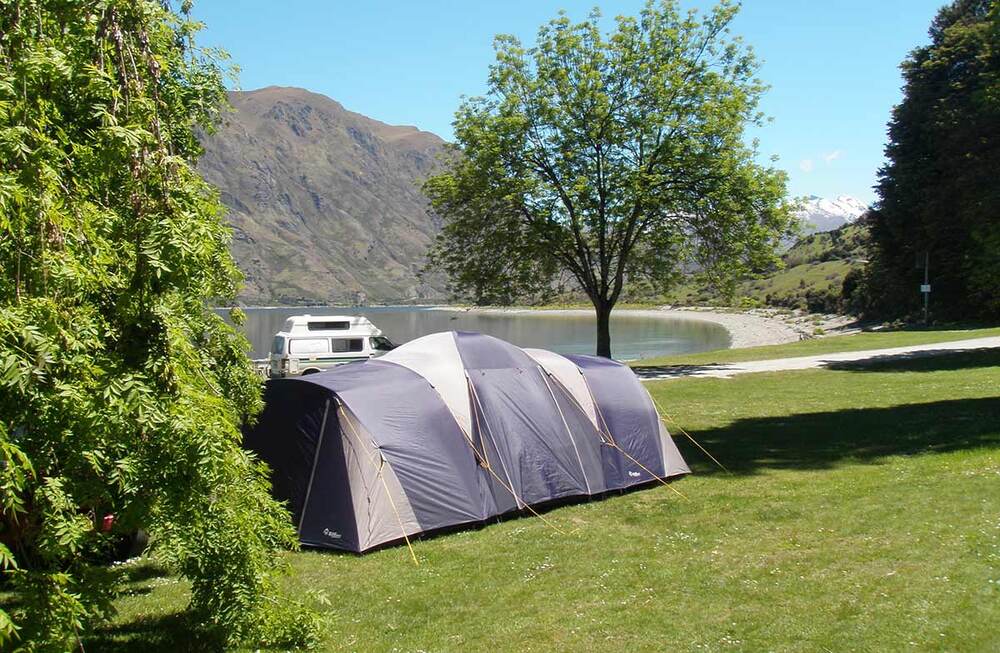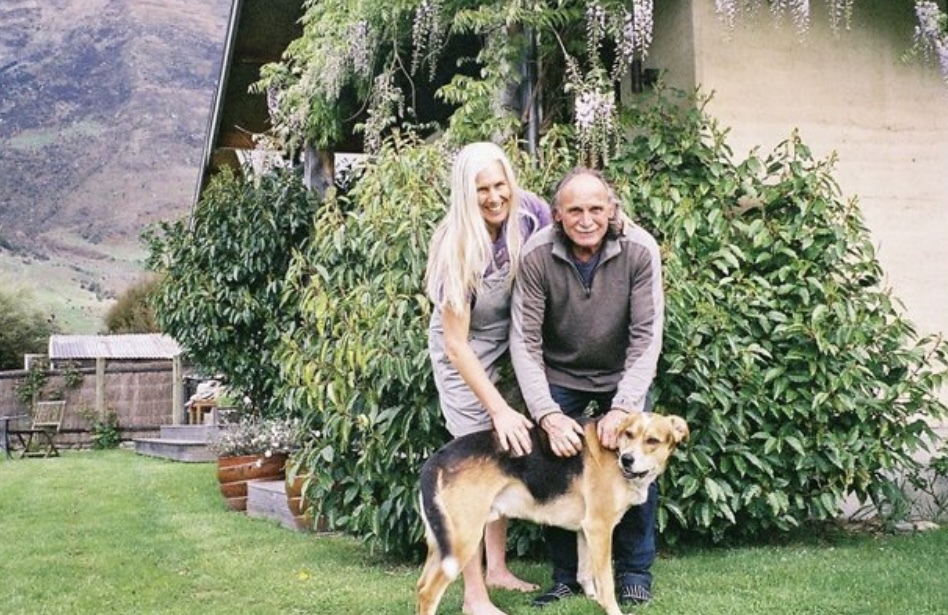DOC dilemma: locals frustrated, tourists ‘laughing at us’
Sue Wards
04 February 2024, 4:04 PM
 A very long wait for toilets: It’s been three years since the toilets at Boundary Creek campsite were found to be non-compliant. PHOTO: Wānaka App
A very long wait for toilets: It’s been three years since the toilets at Boundary Creek campsite were found to be non-compliant. PHOTO: Wānaka AppPressures on the Department of Conservation (DOC) are having a significant impact on the Wānaka area, with locals voicing frustration at the neglect of ‘front-country’ assets.
A Makarora accommodation provider has voiced his frustration about neglect around Mt Aspiring National Park, including the closure of the Blue Pools and Rob Roy Glacier access bridges, the three-year closure of Boundary Creek campsite, and an overall reduction in DOC services.
“Accommodation providers are pretty pissed off,” Wild Earth Lodge owner Pete Phillips told the Wānaka App.
Pete said hundreds of people crossed the Makarora River in just one day last week to access the Blue Pools.
Pete and Janine Phillips of Wild Earth Lodge in Makarora. PHOTO: Supplied
With tourists, fishermen, and trampers using the popular area it’s been lucky no one has been swept away, he said.
“An Asian guy walked from the river mouth to the Blue Pools the other day; he hopped in the river and was about to be swept away,” Pete said. Luckily the man realised in time and was able to get out.
“We’ve had a very changeable summer. [DOC] is lucky they’ve got away with it.
“They built a beautiful new car park and toilet facilities and a brand new track - and they’ve dropped the ball on the bridge: the most important piece in the puzzle.”
Pete said DOC knew the bridges (the Blue Pools and Makarora bridges, both on the popular Blue Pools Track) were “not OK”, and after three years of the border being closed due to Covid-19, “they knew we were going to get slammed”.

DOC operations manager Nicola Holmes (who has been in the role since early 2021) told the Wānaka App that tenders were open for construction of the Blue Pool bridges and there would be a clearer time frame for completion once contractors were secured.
Pete said he has been told the bridge[s] may not be ready until October. He questioned why Fox Glacier was able to get a Bailey Bridge installed within four weeks, while the Blue Pools bridge[s] remained closed with no completion date in sight.
“We’re not talking about building a skyscraper. It's a 40m span bridge.”
Pete said DOC should apply to central government, iwi, Forest & Bird, and trampers’ groups for funding to fix the bridge urgently.
“Everyone is being put at risk,” he said.
Redundancies, closures; holding on three years for toilets
And it’s not only one spot, Pete said.
“It’s Rob Roy, campgrounds closed, campgrounds with plastic portaloos - it’s not a good look. Tourists are laughing: ‘what’s with all the portaloos?’.”
Makarora is “the gateway to Wānaka from the glaciers”, but the area now has just one DOC worker, Pete said.
In the past few years the Makarora Visitor Centre has closed and experienced staff have been made redundant. DOC’s four bedroom house is occupied by the lone staff worker, right next door to a relatively new DOC workshop full of gear.
Meanwhile staff are driving “all the way from Wānaka” to the area to mow lawns, he said.
DOC has been closing assets down “without any notification”, Pete said. He had recently learned that DOC intends to pull down the former visitor centre because it would need to be upgraded to be reopened.
“We want to try and hold on to what we’ve got in Makaora. I’ve lived here for 15 years and I’ve seen things going backwards.”
In late 2021, the toilets at Boundary Creek Campsite and Kidds Bush were found to be non-compliant with their resource consents. A portaloo was installed at Kidds Bush while Boundary Creek campsite was closed.
Three years later, DOC is emptying the Kidds Bush portaloos twice weekly - and more often if it gets reports they are full between times, a DOC spokesperson told the Wānaka App.

DOC is sending trucks to Kidds Bush at least twice a week to empty portaloos which were installed three years’ ago. PHOTO: Supplied
The Kidd’s Bush toilets were “full and stinky” last week, a camper told the Wānaka App.
Pete said DOC would be better off spending money to upgrade the Kidds Bush toilets rather than sending trucks up there to empty portaloos twice a week.
DOC told the Wānaka App on Friday (February 2) it had “no immediate plans” to reopen Boundary Creek Campsite, which was closed three years ago because the toilets needed to be upgraded.
Nicola said “while the Boundary Creek campsite did get some use, particularly from day trippers, overnight use was low, compared to a lot of our other sites”.
Pete said every time he went to the Boundary Creek campsite when it was open “it was packed”.
Boundary Creek provided one more place for freedom camping and its closure means more pressure on other areas, such as the “over-run” Cameron Creek site further up the road towards Haast, he said.
DOC ‘in a really tough space’
Queenstown Lakes District deputy mayor Quentin Smith told the Wānaka App that DOC is “not really looking after our assets”, and the organisation is focusing more on the back country parts of Mt Aspiring Park.
He cited reports of neglect at Kidds Bush campsite, maintenance of the Outlet Track and other local tracks, as well as the well-publicised bridge closures.
It’s “incredibly disappointing” that the Boundary Creek campsite remains closed, he said.
“If they’re not reopening the campground they should at least restore access to the site.
“There’s no question [DOC] don’t have enough funding to do what they need to do; we’re at the suffering end of that,” he said.
“It’s one of the reasons why council is looking at taking over the DOC part of Mt Iron so that we can manage it in a cohesive way.”
Lake Wānaka Tourism (LWT) general manager Tim Barke said he understands that DOC, along with other government departments, is facing “significant reduction in funding and are managing increasing biodiversity threats with growing numbers of threatened species, increasing damage related to climate change and significant weather events, and a large portfolio of ageing infrastructure (huts, tracks etc)”.
“The Department is in a really tough space to try and manage all of these competing challenges and with funding being further cut, I imagine they are working hard to work out what they can do and what they just don't have the funds for,” he told the Wānaka App.
Go deeper: Tourism boss slams DOC delays
‘Consistent underinvestment’ - DOC
DOC’s briefing to incoming conservation minister Tama Potaka this month stated the problem baldly: “Management of visitor assets, tracks and heritage sites is inadequate.”
“DOC now manages more assets than we can afford to maintain in the long term,” the briefing stated.
“This gap is getting larger due to a growing backlog of planned maintenance work, and the ongoing transfer of low-value, high-cost assets to DOC. Consistent underinvestment in the renewal and replacement of assets is reaching a critical level.”
DOC’s asset base has grown over time, and within current resources it will not be possible to address the impacts of “escalating pressures from extreme weather, fire and flood”.
Nicola told the Wānaka App that DOC Wānaka must prioritise its work programme.
“Across Central Otago DOC manages and maintains more than 1,500km of tracks, 238 structures such as boardwalks, pedestrian bridges, vehicle bridges, viewing platforms, and marine structures, 103 toilets and 49 huts, alongside our important biodiversity, predator control, community work and concessions authorisations.”
What now?
DOC has proposed a range of funding scenarios for the new government for “a more sustainable activity and asset base”.
“The government will need to consider the costs and benefits relating to growing versus maintaining or reducing conservation assets and services,” the briefing to the new minister said.
“A broader review of the role of third-party funding in meeting the future sustainability of DOC, including through user-charging, is required.”
DOC said it has a range of formal partnerships with third parties such as businesses and NGOs that bring in additional resources to deliver more conservation, and the government “could seek to expand on this and clarify the future role of third-party investment in conservation funding”.
Pete told the Wānaka App he had a meeting scheduled with DOC and LWT last Friday, which was cancelled at the last minute. He said he is looking forward to a rescheduled meeting.
Recent American visitors “were laughing at how cheap it was in New Zealand”, he said.
“They could not believe that you could go anywhere in the national park and not pay. It’s revenue going down the toilet,” he said, adding that the government needs a tourism levy at the border.
Meanwhile Nicola told the Wānaka App we’re “incredibly lucky in Central Otago to have a vast backyard to explore, and the vast majority of DOC sites and structures are open and ready to welcome visitors”.





